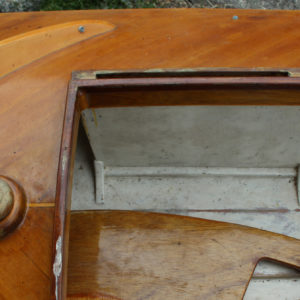When I decided to follow the route Nathaniel Bishop took from Pittsburgh, Pennsylvania, to Cedar Key, Florida, in the winter of 1874–75, I chose not to build a replica of his CENTENNIAL REPUBLIC, the sneakbox at the heart of his book, Four Months in a Sneak-Box. I was drawn to build instead the Barnegat Bay sneakbox detailed in Chapelle’s American Small Sailing Craft because it had an intriguing feature: a daggerboard set 10″ to starboard, on the outside edge of the cockpit coaming. Bishop’s boat had its daggerboard just aft of the mast, on the centerline, where you’d expect it to be. Chapelle offered good reasons for moving the board to one side.
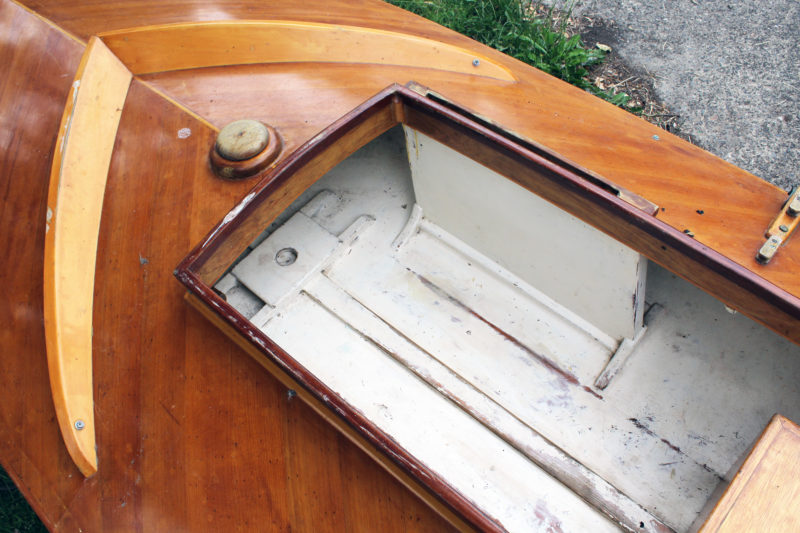
The offset daggerboard of my sneak box convinced me that there were no significant advantages to having the elements of the sailing rig all set on the centerline. I slept with my feet tucked under the foredeck. I occasionally put the hatch over the cockpit opening for warmth or to keep the rain out. The boat was only 14″ deep, so with the lid on I could understand why the sneakbox was known to some as “the devil’s coffin.”
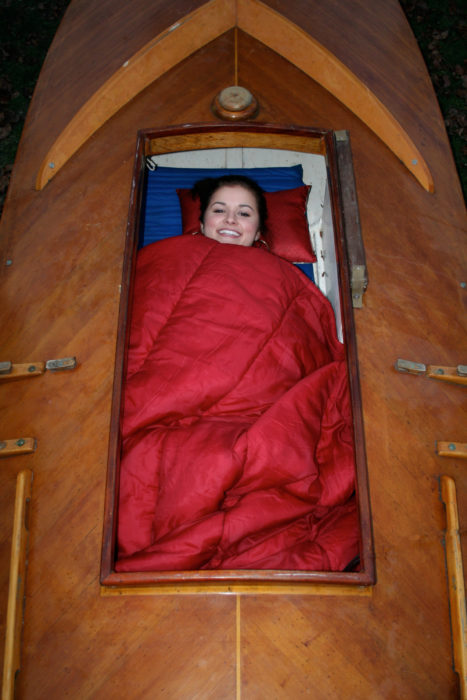
There would be no smiles trying to get to sleep with a centerboard hogging the middle of the sneakbox.
“The gunners often spent a couple of days away from home, during which they lived and slept in their small skiffs. The cockpit had to be large enough and sufficiently clear of obstruction to permit stretching out in some comfort. When the daggerboard was introduced, it was decided that its case must not obstruct the cockpit, so it was placed well off center in the boat—just outboard of the cockpit coaming. Such an unorthodox position of a centerboard did not disturb the Jerseyman, whose artistic regard for symmetry and been blunted by long years of acceptance of a single lee board.”
I didn’t expect to do much sailing on the first two legs of the journey—the Ohio River and the Lower Mississippi—but I would be sleeping aboard. Moving the daggerboard case out of the way was worth a try, even if it meant losing a measure of sailing performance on the last leg, along the Gulf of Mexico where I’d find wind and open water.
I cold-molded my sneakbox, so it was an easy matter to put the daggerboard case off-center. Monocoque construction, whether cold-molded, stitch-and-glue, glued-lapstrake plywood, or strip-built, carries its strength in the unified skin of the hull, lending itself to moving daggerboard and centerboard cases without having to work around traditional planks and frames. I just cut slots in the sneakbox’s deck and hull, and glued the trunk in.
I set out from Pittsburgh in November of 1983 and spent many nights sleeping aboard my sneakbox, LUNA. I appreciated the room I had to stretch out as well as the protection the fully decked boat offered from wind and rain. When I reached the Gulf I did a lot of sailing, including a day’s 62-mile sail around Big Bend, the open-water passage along the Florida coast that bends from its panhandle to its peninsula. I was never able to feel any difference between tacks with the offset daggerboard. Whatever difference there might be, it was less than the difference I could feel between having the sprit mainsail creased around the sprit on one tack, and curved smoothly to leeward of it on the other. I was sold on the offset board, and I haven’t built a boat with a board on the centerline since then.
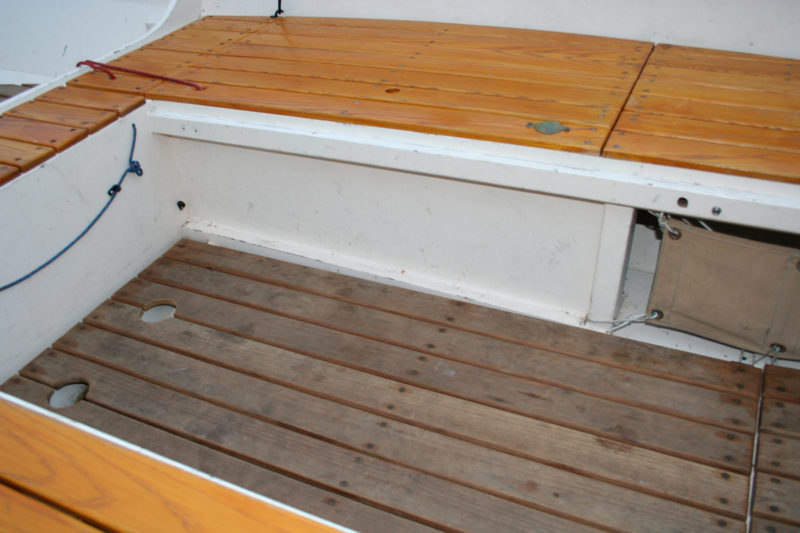
The off-center-board case in my Caledonia yawl supports the starboard bench. It’s so inconspicuous that I often forget to lower the board when I set sail.
My Caledonia yawl has its “off-center-board” case set 12″ to starboard. The wide garboards of the glued-lapstrake plywood made the move fairly simple and left the center of the cockpit clear. On rare occasion, driving the yawl hard to weather on the starboard tack, I’ve been able to see the top of the board come clear of the water if I lean over the windward rail, but I’ve never detected any increase in leeway or decrease in speed.
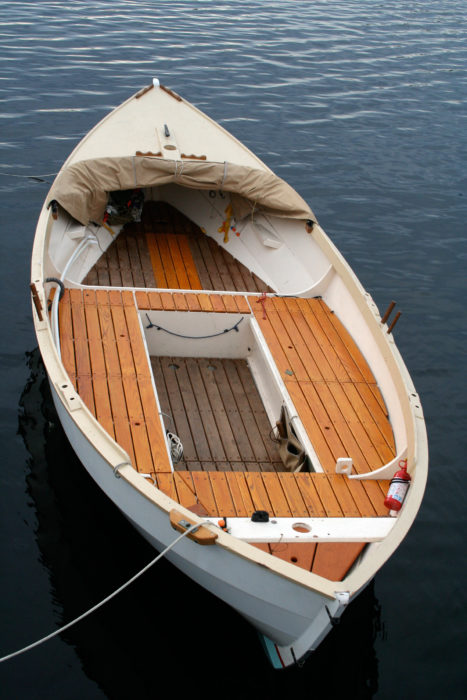
The center of the yawl’s cockpit is clear but for one bench/bulkhead combination. I can move from end to end to end very quickly with my shins intact.
My cruising garvey also carries its off-center-board to starboard, leaving a clear path down the middle of the boat. I carried the off-center idea a step further and moved the mizzenmast as far to starboard as I could, 18″ off the centerline, to give me room to work with the rudder and the outboard motor. The garvey is no racehorse under sail, but it is well mannered even with the main and rudder on the centerline and the mizzen and board offset.
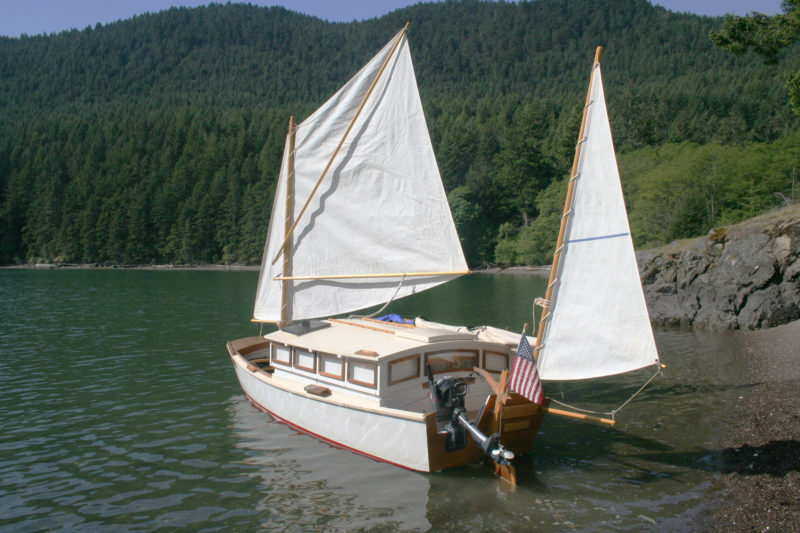
The mizzen mast on my garvey is set to starboard, clear of the tiler and the outboard. The boat’s off-center-board is also to starboard.
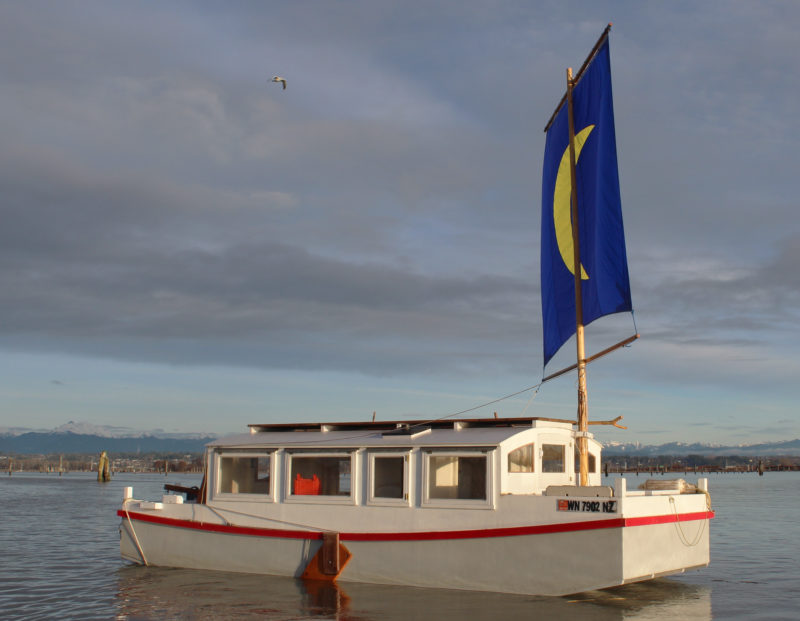
The outboard-powered canal boat wasn’t designed to sail, but with a leeboard (set 36″ to starboard) and a mast (set 18″ to port) we can rig for silent running without interfering with the normal use of the boat, which includes diving into the water from the cabin-top catwalk.
Our canal boat, lately rigged for sail, has its mast and leeboard well out of the way. And my Gokstad faering, of course, has its rudder hung on the starboard side, in Viking fashion. Our word starboard is derived from the Old English steorboard, meaning “steer board.” Before vessels were equipped with rudders set on the centerline, they were steered with boards hung on their sides, so putting the elements of a sailing vessel off to one side has a long history. The space in small boats is limited; I prefer to keep as much of that for myself rather than give it away to masts and boards in blind devotion to symmetry.![]()

